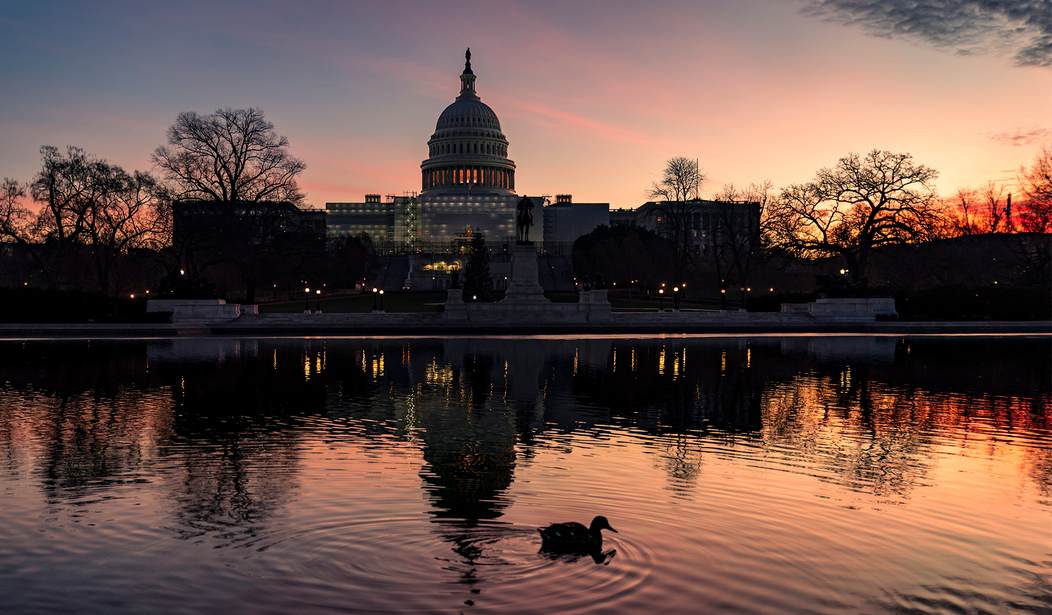The Uniparty in Congress is once again engaged in its recurring haggling over how to avoid a government shutdown, with the next deadline set to arrive in a matter of days. Everybody says the House Republicans must lead on the process.
I suggest that the Republicans do just that: lead. It will take some nerve, something congressional Republicans almost never show.
Note that government shutdowns always loom, and ominously. They never arise on the horizon like the beautiful, hopeful sunrise that they really signify. Just imagine a smaller, less intrusive federal government doing less economic and social damage! The heart sings at the prospect.
Anyway, the possible scenarios for avoiding a beautiful shutdown are an agreement on all the needed appropriations bills (highly unlikely because this is Congress, after all), no deal and a long shutdown (highly unlikely because Republicans perceive it as politically damaging), a last-minute omnibus bill (unlikely because it would involve a whole lot more work pronto, plus many Republicans know it would be horrendous), or a continuing resolution to keep the government going for some specified span of time (a possibility because the other options are pretty much out of the running for the reasons noted).
The conservative Freedom Caucus in Congress has long been pushing for a return to regular order, in which Congress votes on 12 annual appropriations bills, with each standing or falling on its own merits. The present Congress has passed seven of the 12 appropriations bills, and five of those are set to expire on March 1. That means Republicans and Democrats in the House and Senate would have to agree on 10 appropriations bills within the next few days.
The only way that will happen is for Republicans to give President Joe Biden and the Senate Democrats all or nearly all that they want.
OK, that definitely could happen.
The Freedom Caucus has now changed course and is supporting a continuing resolution. That would establish an across-the-board spending cut of one percent on April 30, under the terms of last year’s debt ceiling deal.
Of course, the Democrats will never stand for that. In addition, a continuing resolution would bring back the corrupt budget-deal system that has fostered the current massive deficits and unsustainable debt, which the fiscally conservative Freedom Caucus rightly opposes.
A budget cut is a budget cut, however, so how about the congressional Republicans finally show some smarts—and guts—and invite the Democrats to throw them into that briar patch? Republicans would be averting a supposed disaster, and the Democrats would be the ones shutting down the government for a piddling one percent reduction of a budget the American public already knows to be grotesquely bloated and corrupt. “Democrats are so addicted to debt spending that they won’t even accept a teeny weeny cut of less [than] $50 billion out of a $6 trillion annual budget,” the Committee to Unleash Prosperity notes.
I have an even better idea for the Republicans—and for America. Bring to the floor a bill to restore federal government spending to its 2019, pre-pandemic level.
In 2023, the federal government spent about $6.4 trillion. In 2019, the government spent approximately $4.8 trillion.
Offer $4.8 trillion for the next fiscal year. Propose cuts of $1.6 trillion from defense, food stamps, welfare and social spending, Medicaid expansion (cap spending on it), and the like while allocating more for border control.
Then, let the Democrats complain about that as much as they want. Keep pointing out that in 2019, the nation was doing quite well, the economy was growing, income inequality was shrinking, and the border was being protected far, far better. Stick to that.
Republicans, in this scenario, do not answer any other questions or discuss any specific claims of expected disasters from the cuts. They do not try to refute any sob stories of individual and group victims of the “cruel,” “draconian,” “reckless” budget cuts. Republicans just keep saying that the nation was at its recent peak of economic success with the 2019 budget, and they only want to return us to those fine, sunny days of normal ravenous federal government greed and overreach relatively sensible federal spending.
Meanwhile, the Republicans must continually remind people that the Democrats are threatening to shut down the government, and then that those stubborn Democrats have already done so. Stress the fact the Democrats are objecting to a one percent reduction of the irresponsibly rapid growth of federal spending under President Joe Biden—which the public has already said they hate.
At the last moment, when everybody is sweating profusely over the coming shutdown catastrophe or the government has already shut down and nothing bad has happened (which will really put the big spenders up against the wall), Republicans should once again offer the continuing resolution with the automatic, across-the-board one percent spending cut, and vote for it if the Democrats agree to the deal.
Until then, do not budge.
That would be a major change of strategy, in which the Republicans play the game the way the Democrats do: to win. Ask for what you really want, and then accept only the very best you can get.
That leaves only one question. Do the Republicans really want a less disastrous federal budget?
S. T. Karnick (https://stkarnick.substack.com/) is a senior fellow and director of publications for The Heartland Institute, where he edits Heartland Daily News and writes the Life, Liberty, Property e-newsletter.














Join the conversation as a VIP Member